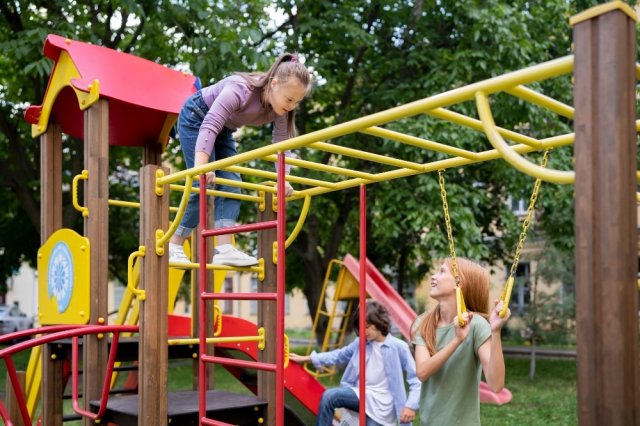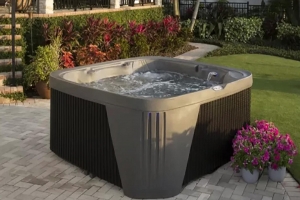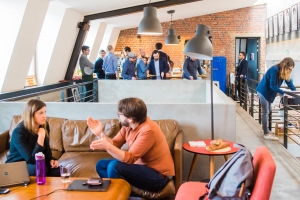Community organizations are responsible for ensuring that the neighborhood is clean, friendly, and safe. This includes creating a central location for gathering and interacting with others. This is essential for communities because durable playground equipment allows families to enjoy the outdoors while making new friends and getting exercise. That said, they should be accessible and inclusive to meet the needs of all types of residents.
Parks with playgrounds and other common spaces are not only beneficial for children, but they are good for the entire community. Your community can grow and improve with a fully functional park area. Read on to see how your neighborhood can benefit from a well-built community park.
Physical Activity
Many kids spend a lot of time indoors on a device like their cell phone, computer, or tablet. A community park with engaging playground equipment changes all that. It encourages children to be outside in the sunshine, while getting them to be physically active.
According to the CDC, kids ages 6-17 should get at least 60 minutes of exercise per day. Sadly, only 24% of children actually get the recommended amount of exercise. While school PE classes help, they don't do enough. They are limited to a single class period. Oftentimes, teachers spend much of that time explaining the rules of the game or activity.
Playgrounds give kids an outlet to burn off energy and get needed daily exercise. Many kids don't have a place to go play, and a community park provides this space. They encourage children to use their imaginations and play how they want to play, unlike a structured gym class. Kids engage in high-energy play, like jumping, climbing, and running.
Social Interaction
The shared space of a community park allows for children to interact socially. They can meet new people of different age groups, others with different abilities, and children outside their normal friend circle. At school, kids tend to play at recess with the same group of kids, usually all in their grade, but that can limit their exposure to diverse perspectives and experiences.
With so many ways to play at community parks, kids are bound to run into others that want to join in. They can play that they're on a pirate ship, in space, or break off into teams for an adventure. This open-ended play allows for kids to hone their social skills with others in their neighborhood. They may even be able to regularly meet up to play together, since there is an outdoor public space for that.
Even parents and caregivers get the opportunity to form connections at playgrounds. Since most friendships are formed at school, it's difficult for parents to get to know other parents. Yet at the playground, they are able to interact with other families in the neighborhood. Community parks bring together people of all ages, developing a common bond between families.
Inclusivity
It's essential to design a playground that is inclusive for all types of abilities, serving the entire community. For starters, make sure that the entire playground is on a single, level platform. If there must be different levels, use gentle ramps rather than steps to ensure kids in wheelchairs can ascend easily. The surface should be slip-resistant and shock-absorbent as well.
Group playground accessories in zones, using the same type of equipment with varying levels of difficulty. For instance, you might place swings that are high off the ground next to ones that are average height. Then nearby, add baby swings and swings for those in mobility devices. They should all be in the same area. This allows children of all abilities to play together and get to know each other. This range of challenges also allows children to continue to find enjoyment as they grow and learn. They can push their limits and improve their skills.
You should also include sensory play panels within the playground. Different textures, die-cut letters and numbers, and sensory panels are fun for children of all abilities and age levels. These interactive elements engage children's senses while also supporting their cognitive and motor skill development. They can make the playground a more enriching and educational place.
Community Well-Being
When you think of playgrounds, you usually think of children enjoying the facilities. But adults can make use of community parks, as well. All age groups can enjoy playground equipment, getting out there with their children to play. Show your kids how it's done. Swing on the swings, go down the slides, and lift your feet high and go on the monkey bars. You haven't forgotten how to play.
A well-designed park should make families want to spend time outdoors being active. And that has so many benefits! Physical activity reduces the risk of obesity, heart disease, diabetes, and other conditions related to a sedentary lifestyle. The well-being of an entire community can be improved through a durable playground.
Beyond the physical benefits of a playground are the emotional advantages. The fresh air and elements of nature can create a calm, peaceful feeling that induces relaxation. Trees and flowers add to the beauty of the park, improving your mood and reducing stress. Stop and smell the roses. It literally helps improve your health, fighting depression, decreasing inflammation, and helping you sleep.
Playground Equipment Matters
Neighborhoods that have access to a shared park area are more likely to be physically and emotionally healthy. They have more friendships and stronger bonds to the community. Children enjoy the benefits of playground equipment, and all kids feel included and welcome.
As children and their caregivers take advantage of the park, their well-being improves. This causes the whole neighborhood to improve, making it a desirable location to live. Communities will see a burgeoning number of new residents and empty houses will fill with families. Community organizations that want to see a happy, healthy, and friendly neighborhood should design a park with playground equipment.






